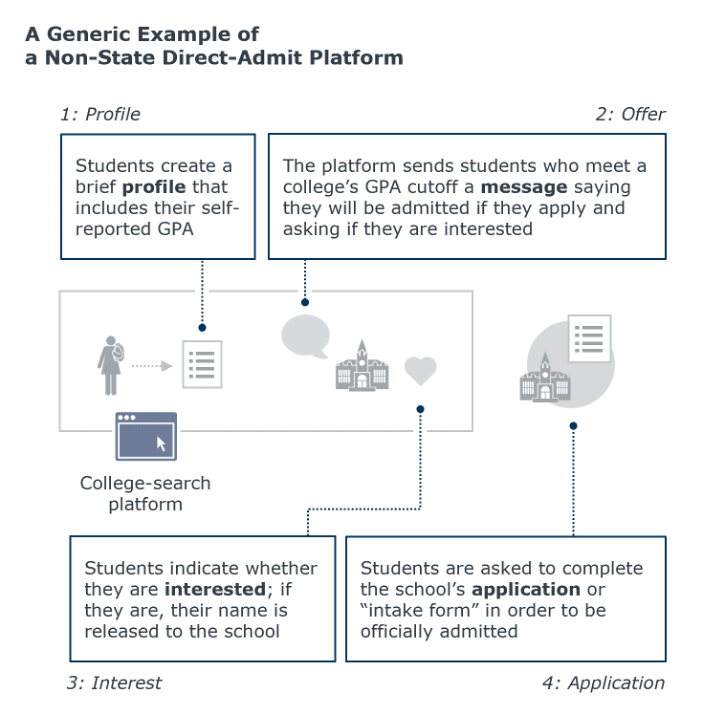Five things to know about the new direct-admission landscape
A steep growth curve for direct admission
Recent months have seen a rapid proliferation of direct-admission programs nationally and an increase in the number of participating students, colleges, and universities. The number of schools signing on for the largest non-state initiatives (e.g., the Common App Direct Admissions program and EAB’s Match platform) grew by 85% between 2023 and 2024, and more than 400,000 students received direct-admit offers through such platforms for entering class 2024. Of the 20 or so existing state programs, more than a quarter were established in the past year.
This trend presents enrollment leaders with some urgent questions: Should you embrace direct admission? If so, what version of it? And what impact, if any, will it have on your team’s work and on your recruitment funnel?
View our on-demand webinar, “A Guide to the Direct-Admission Landscape”
EAB answers these and other questions in our new insight paper, “A Guide to the Direct-Admission Landscape.” Included in the piece are:
- An overview of the different types of direct admission
- A review of the evidence regarding its efficacy
- An examination of the overlap between direct admission and recruitment marketing
- A self-test for whether you should embrace direct admission
- A tool for evaluating potential direct-admission approaches and partners
- Case studies of schools that have implemented direct admission
I’ll refer you to the full report for more detail on those points. But I did want to share with you some higher-level takeaways, in the form of five conclusions.
Five conclusions regarding direct admission
1. Direct admission is entering a new era
While state-sponsored direct admission has been around for years, newer, non-state players are transforming direct admission in profound and exciting ways. Most notably, it is now possible for colleges and universities to make proactive admission offers to students directly within popular online college-search platforms. This represents a major advance, making it far easier for students to discover schools who want to admit them and to accept offers from these schools. Innovations like this are poised to transform the role that direct admission plays in the lives of college-bound students and the schools seeking to enroll them.
2. Fully developed direct-admission approaches have two defining features
The most effective direct-admission approaches share two key elements: 1) proactively informing students that they qualify for admission and 2) reducing to an absolute minimum steps students must take to receive and confirm admission offers (e.g., minimizing information they are required to submit). While either is worth pursuing on its own, the greatest benefit comes from implementing them in tandem. Note that you will often hear approaches that feature just one or the other of these two elements referred to as direct admission.

3. Direct admission is student-centered
Direct admission can undoubtedly benefit colleges and universities. That said, it is best understood as a way of helping students. One of the more compelling ways it does that is by positively impacting their mental health. More than half of high schoolers rank applying to college as the most stressful thing they have experienced in their academic life. It is easy to imagine how big a difference eliminating the hardest tasks related to it, as direct admission does, would make to students’ well-being and to keeping them on the path to college.
4. Direct admission is becoming an important way to compete for students
Schools adopting direct admission enjoy a competitive advantage, insofar as it enables them to better engage students during the recruitment process relative to competitors who are not doing direct admission or who are not as good at it. Maintaining that competitive edge as direct admission becomes more widespread will depend on continued innovation in your approach.
5. Effective recruitment marketing remains critical
All of the things that recruitment marketing helps you do more effectively at present remain at least as relevant under direct admission. That includes identifying students to recruit, building affinity with them, getting your offers in front of them, framing those offers in terms that appeal to them, building competitive aid awards into your offers, and maximizing yield. Important context in this regard is the fact that direct-admitted students tend to yield at lower rates than conventional admits, which means you’ll want to work as hard as ever to build relationships with them, before and after they’re admitted.
More Blogs

What enrollment leaders can learn from Alabama’s statewide direct admissions program

Is your yield rate okay?
